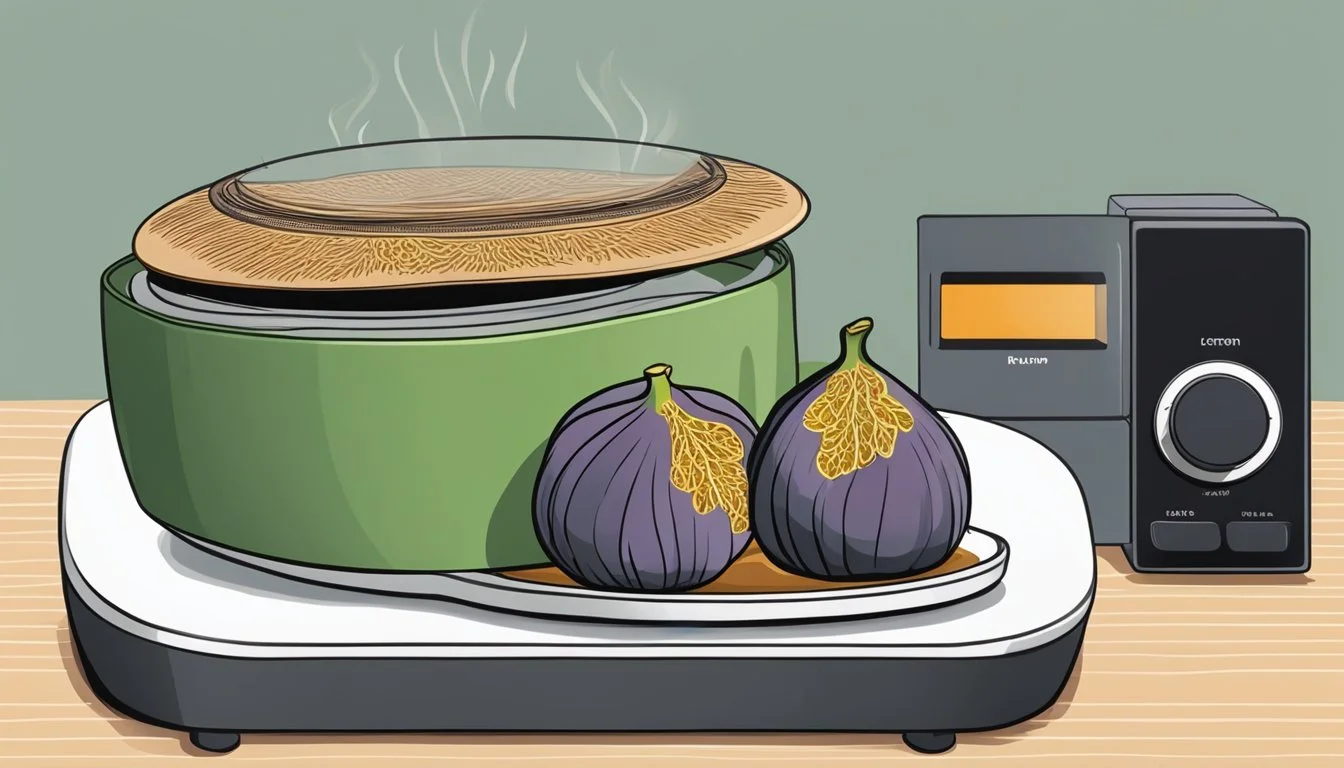How to Reheat Fig
Best Techniques for Maximum Flavor
Reheating figs, whether fresh or dried, requires a delicate balance to preserve their texture and flavor. Using a steam method is one of the best ways to reheat figs, as it ensures even heat transfer without drying them out. For this method, place the figs on a steaming tray and steam them over boiling water for a few minutes until they are warm and plump.
Alternatively, the microwave can be a quicker option for those in a hurry. Arrange the figs on a microwave-safe plate, cover with a damp paper towel, and heat them in short 10-second bursts to avoid overheating. For a more savory touch, consider using a reheat cycle on a low heat setting in your oven—this is particularly useful for larger batches.
Each method has its advantages depending on the type and quantity of figs you need to reheat. Steaming is ideal for maintaining moisture, while microwaving is efficient for single servings. Ovens provide controlled, even warming, making them great for multiple servings.
Understanding Reheating Process
The process of reheating food involves various mechanisms that are crucial to retaining moisture, texture, and flavor. Specific techniques and devices can be utilized to achieve optimal results.
Basics of Heat Transfer
Heat transfer is fundamental in reheating food. The primary methods are conduction, convection, and radiation.
Conduction: Direct contact, such as placing food on a hot surface, facilitates heat transfer.
Convection: Circulating hot air transfers heat more evenly. This is common in ovens and air fryers.
Radiation: Infrared or microwave radiation penetrates food and heats it internally.
Thermal Efficiency is a key factor. Higher efficiency means less energy is wasted, resulting in more consistent reheating. Proper use of heat transfer methods ensures the food heats evenly and retains its quality.
Role of Steam in Reheating
Steam helps in retaining moisture and reheating food more gently.
Using steam effectively can be achieved by:
Covering the food with foil or using a steam tray to trap steam.
Adding a small amount of water or broth: This generates steam during reheating.
Using specific devices: Steam ovens or steam racks in regular ovens are useful.
Steam prevents food from drying out and maintains texture, especially for items like bread, pizza, or delicate proteins. Proper steam utilization enhances the reheating process by ensuring that moisture is absorbed evenly throughout the food.
The Reheat Cycle Explained
The reheat cycle involves gradually raising the temperature of the food to a safe and enjoyable level.
Initial Warm-Up: Start at a lower temperature to increase internal heat without burning the exterior.
Temperature Maintenance: Maintain a consistent temperature to evenly distribute heat.
Final Boost: Increase the temperature slightly at the end to ensure thorough reheating.
In industrial settings, the Rankine Cycle may be referenced, which involves reheating steam in thermal processes. At home, the cycle is simpler but follows the same principle of gradual heating followed by stabilization and potential final bursts of heat. This process is essential for preserving flavors and textures.
Preparation for Reheating
Preparing to reheat figs involves determining the correct temperature and handling them properly before reheating. This ensures both quality and safety.
Determining the Correct Temperature
When reheating figs, it is essential to identify the proper temperature to avoid overcooking. Using an oven, a common approach is preheating to 350°F (175°C). This setting helps to warm the figs evenly.
Microwaving: For more convenience, use a lower temperature setting to maintain the figs' natural texture and flavor. Optionally, consider using a microwave-safe cover to prevent moisture loss. Regularly check the figs to avoid overheating. Adjust temperatures gently according to the equipment being used.
Storage and Pre-Reheat Handling
Proper storage techniques are crucial. Refrigeration: Keep figs in an airtight container to maintain freshness and prevent contamination. When ready to reheat, allow them to come to room temperature for about 10-15 minutes, aiding in even reheating.
If the figs were previously frozen, thaw them in the fridge overnight to preserve their texture and taste. For added moisture retention, sprinkle a small amount of water over the figs before reheating. Maintain cleanliness throughout the handling process to ensure the figs are safe to consume.
Reheating Techniques
Effective reheating ensures food retains its texture, flavor, and safety. Various methods leverage different principles, such as steam, boilers, and oil.
Using Steam for Reheating
Steam provides gentle and even heat, making it ideal for reheating delicate foods. This method ensures moisture is retained, preventing dishes from drying out. To steam, boil water in a pot and place a steam rack above it. Ensure the food doesn’t touch the water. Cover the pot and allow the steam to heat the food evenly.
A key benefit of steaming is its efficiency in preserving nutrients while achieving uniform heat transfer. Safety is also a consideration; using indirect heat minimizes the risk of burning or overcooking.
Reheating with a Boiler
Using a double boiler is another effective technique, often utilized for reheating sauces, chocolate, and other sensitive items. Place water in the bottom part of the boiler and the food in the top pot. The top pot should fit snugly but not touch the water. Heat gently and stir occasionally.
This method allows for gradual warmth, reducing the risk of overheating and scorching. Efficiency in this process is high, as the boiling water provides consistent, indirect heat.
Oil-Based Reheating Methods
Oil-based reheating is excellent for foods that benefit from crispiness, such as fried items. Start with a small amount of oil in a skillet over medium heat. Place the food in the hot oil and turn it frequently to avoid burning and ensure even heat distribution. Oils with high smoke points, like canola or peanut oil, work best for this process.
This method ensures efficient heat transfer and can reintroduce the desired texture to certain dishes. It’s crucial to monitor the process closely for safety, as oil can quickly overheat and pose a fire risk.
Optimizing Thermal Efficiency
Optimizing thermal efficiency involves making the most effective use of heat exchange and improving the efficiency of the reheat cycle in power plants. This requires careful attention to system design and operational parameters.
Maximizing Heat Exchange
Maximizing heat exchange is crucial in improving thermal efficiency. By optimizing the heat exchange processes, more energy can be harnessed from the fuel, reducing waste.
Heat exchangers must be designed to have a high surface area to volume ratio. This ensures that heat transfer is maximized.
The condenser, where steam is cooled and condensed, needs efficient cooling mechanisms. Using advanced materials in the condenser can enhance heat transfer, reducing heat loss.
Regular maintenance of heat exchangers and condensers is essential. Deposits or fouling can significantly reduce heat exchange efficiency, leading to higher fuel consumption.
Improving insulation in the heat exchange systems prevents heat losses, further enhancing overall thermal efficiency.
Efficiency in the Reheat Cycle
The reheat cycle is a critical component in thermal power plants. By reheating steam that has partially expanded, it's possible to increase the thermal efficiency of the cycle.
During the reheat process, steam from the turbine is returned to the boiler and reheated. This reheated steam is then directed back to the turbine for further expansion, which results in more work output.
Effective temperature and pressure optimization during reheating can significantly impact efficiency. Ensuring that reheating occurs at the optimal temperature is essential for maximizing energy extraction.
Utilizing advanced materials and technologies for turbines and reheaters further promotes efficiency. Materials that withstand high temperatures and pressures ensure reliable performance and reduce wear.
By integrating these practices, plants can enhance their thermal efficiency, transforming more heat into useful work and reducing fuel consumption.
Equipment and Tools
Reheating figs properly requires specific equipment and tools, each playing a crucial role in ensuring the fruit retains its moisture and flavor while being warmed up.
Selecting the Right Turbine
A critical factor in reheating figs is the choice of the turbine for airflow control. Convection ovens are ideal, as they use a fan and exhaust system to circulate hot air, creating even heat distribution. This ensures figs are evenly reheated without hot spots, preserving their delicate texture.
Microwave ovens equipped with inverter technology can also be useful, as they allow for precise power control, reducing the chances of overheating. While microwaves are quick and convenient, caution is needed to avoid drying out the figs.
Role of Pumps and Condensers
Pumps and condensers are essential for managing moisture levels during the reheating process. An oven with a steam injection pump can add moisture back into the figs, which is critical for maintaining their juiciness.
Sous-vide machines are another option, offering precise temperature control. By sealing figs in a vacuum bag and immersing in a water bath, sous-vide machines keep figs moist and flavorful. Condensers in certain ovens collect and redistribute steam, aiding in even heating and preventing dryness.
Understanding Generator Functions
Generators in heating equipment are responsible for providing the necessary power and heat levels. Induction cooktops generate heat through electromagnetic fields, ideal for reheating figs in small batches. They offer rapid heating and precise temperature control, reducing the risk of overcooking.
Microwave generators use microwave radiation to heat food quickly. Models with advanced control settings can reheat figs evenly without drying or burning. Ensuring that your cooking devices have effective safety features such as automatic shutoffs and moisture sensors can prevent heat damage to the figs, maintaining their quality and flavor.
Safety and Maintenance
Proper safety measures and routine maintenance are vital for ensuring that reheating figs is both effective and safe.
Ensuring Safe Operation
When reheating figs, it is important to follow specific safety guidelines to avoid accidents and food spoilage. Use a microwave-safe container if microwaving, and ensure there are no metallic parts. Heat figs at a medium power setting to prevent them from bursting or uneven heating.
Always keep an eye on the reheating process, and do not leave the microwave or oven unattended. In an oven, use a baking tray lined with parchment paper to prevent sticking and ensure even reheating. Allow figs to cool slightly before handling to avoid burns.
Routine Maintenance Tips
Regular maintenance of your reheating equipment ensures longevity and efficiency. For microwaves, clean the interior after each use with a damp cloth to remove food splatter and prevent build-up. Inspect the door seal regularly to ensure it’s in good condition, as a loose seal can lead to escaping heat, affecting performance and safety.
For ovens, periodic cleaning of the elements and interior can help maintain optimal heating. Use a soft brush to clean oven racks and ensure they remain free of grease. Check the function settings are working correctly and repair any faults immediately. Consistent maintenance reduces the risk of malfunctions, ensuring a safe and effective reheating process.
Advanced Concepts
Advanced concepts in heat systems such as the Regenerative Rankine Cycle and Combined Heat and Power (CHP) systems offer increased efficiency and sustainability in energy production and usage.
Regenerative Rankine Cycle
The Regenerative Rankine Cycle aims to enhance thermal efficiency by using steam from the turbine to preheat the feedwater. Preheating reduces the fuel needed in the boiler, increasing overall efficiency. In this cycle, extraction points along the turbine route steam to feedwater heaters.
Economical benefits are notable in situations using natural gas as the primary fuel source, where savings on fuel consumption can be significant. Performance optimization hinges on proper placement and sizing of feedwater heaters, which improves thermal efficiency and reduces operational costs.
Combined Heat and Power (CHP)
Combined Heat and Power (CHP) systems, also known as cogeneration, simultaneously generate electricity and useful heat from the same energy source. This dual output significantly enhances energy utilization, leading to an efficiency of up to 80% compared to the separate production of heat and power.
CHP systems are particularly advantageous when integrated with natural gas as a fuel source due to its clean-burning properties. They can be used in residential, commercial, and industrial settings, reducing energy waste and lowering greenhouse gas emissions. Proper maintenance and operation ensure these systems remain efficient and reliable.









